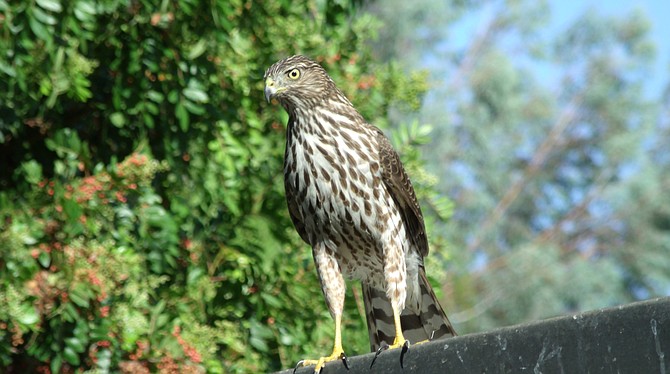 Facebook
Facebook
 X
X
 Instagram
Instagram
 TikTok
TikTok
 Youtube
Youtube

The Smoggiest Days of the Year are most likely to occur during the next several weeks. Persistent temperature inversions (warmer air overlying cool marine air) are frequent this time of year. These inversions conspire with the mountainous topography of East County to trap locally generated air pollution under a low-lying lid. During the worst episodes, San Diego County’s coastal area is the hapless recipient of additional smog sneaking down from the Los Angeles Basin. This often occurs when a Santa Ana wind condition begins to weaken: L.A. smog blown offshore by a Santa Ana may get pushed back our way when the normal sea breeze returns.
Fall Migrant Birds such as wood warblers can be seen at Cabrillo National Monument and its vicinity on Point Loma, Torrey Pines State Reserve, and other parks and open spaces near the San Diego coast. Cooper’s or marsh hawks and even peregrine falcons may be seen following or pursuing these smaller birds.
San Diego’s Coastal SageScrub Vegetation is now at the very nadir of its growth cycle. Shades of gray and yellow have replaced the bright greens that carpeted many of the still-wild coastal hillsides up until April or May of this year. Sometime within the next several weeks, the first substantial autumn rain will shatter the usual summer drought, and our “summer-deciduous” vegetation could bounce back in a matter of days.
The starry W of Cassiopeia stands high in the northeast after dark. The right-hand side of the W (the brightest side) is tilted up. Look at the second segment of the W counting down from the top. Notice the dim naked-eye stars along that segment (not counting its two ends). The brightest of these, on the right, is Eta Cassiopeiae, magnitude 3.4. This is a remarkably Sun-like star just 19 light-years away, and it has a orange-dwarf companion, magnitude 7.3, separation 13 arcseconds — a lovely binary in a telescope. Left of it, and fainter, is a naked-eye pair in a dark sky: Upsilon1 and Upsilon2 Cassiopeiae, a good 0.3° apart. They’re yellow-orange giants unrelated to each other, 200 and 400 light-years distant from us. Upsilon2 is slightly the brighter of the pair. It’s also the closer one.
The above comes from the Outdoors listings in the Reader compiled by Jerry Schad, author of Afoot & Afield in San Diego County. Schad died in 2011. Planet information from SkyandTelescope.org.


The Smoggiest Days of the Year are most likely to occur during the next several weeks. Persistent temperature inversions (warmer air overlying cool marine air) are frequent this time of year. These inversions conspire with the mountainous topography of East County to trap locally generated air pollution under a low-lying lid. During the worst episodes, San Diego County’s coastal area is the hapless recipient of additional smog sneaking down from the Los Angeles Basin. This often occurs when a Santa Ana wind condition begins to weaken: L.A. smog blown offshore by a Santa Ana may get pushed back our way when the normal sea breeze returns.
Fall Migrant Birds such as wood warblers can be seen at Cabrillo National Monument and its vicinity on Point Loma, Torrey Pines State Reserve, and other parks and open spaces near the San Diego coast. Cooper’s or marsh hawks and even peregrine falcons may be seen following or pursuing these smaller birds.
San Diego’s Coastal SageScrub Vegetation is now at the very nadir of its growth cycle. Shades of gray and yellow have replaced the bright greens that carpeted many of the still-wild coastal hillsides up until April or May of this year. Sometime within the next several weeks, the first substantial autumn rain will shatter the usual summer drought, and our “summer-deciduous” vegetation could bounce back in a matter of days.
The starry W of Cassiopeia stands high in the northeast after dark. The right-hand side of the W (the brightest side) is tilted up. Look at the second segment of the W counting down from the top. Notice the dim naked-eye stars along that segment (not counting its two ends). The brightest of these, on the right, is Eta Cassiopeiae, magnitude 3.4. This is a remarkably Sun-like star just 19 light-years away, and it has a orange-dwarf companion, magnitude 7.3, separation 13 arcseconds — a lovely binary in a telescope. Left of it, and fainter, is a naked-eye pair in a dark sky: Upsilon1 and Upsilon2 Cassiopeiae, a good 0.3° apart. They’re yellow-orange giants unrelated to each other, 200 and 400 light-years distant from us. Upsilon2 is slightly the brighter of the pair. It’s also the closer one.
The above comes from the Outdoors listings in the Reader compiled by Jerry Schad, author of Afoot & Afield in San Diego County. Schad died in 2011. Planet information from SkyandTelescope.org.
Comments